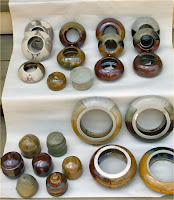Ok!
Lots of stuff in this load. I wanted to make a bunch of lint feeders so I have a good supply. Lower left are the shakers I made. They were featured in this month's PMI - I really like them and loved making them!
I did some glaze testing on them, and got some good and some ugly results.
The firing was to cone 11, fairly heavy reduction.
First one I tried, which I thought would be a nice white glaze for my palette was a simple Shino from Lasse Ostman.
Also from Mr Ostman's site was a Green Matte Crackle.
Lastly was Hamada Rust from John Brit's website.
Not a one turned out as expected. I also experimented with applying a white slip over my dark clay body to brighten some of the glazes. That works well!
The Good:
While Lasse Ostman's Green Matte Crackle didn't turn out at all as I had hoped, I am really liking this glaze! Its pale minty green, flashed with pinky-gray, silky and just begs to be touched. It needs to go on a white clay body (this is Laguna 1/2 stoneware/1/2 porcelain ) and may do something different in oxidation, but I don't do much ox firing. Its definitely a keeper!
The Bad:
I have never done a Shino glaze before, and don't know much about them, but I like them when I see them.
However, my attempt at Lasse Ostman's simple 3/3/3 Shino has some obvious issues.
It should have been a speckled white that breaks nicely. Instead its a greenish semi-matte without much character. Just not anything I can see using. As suggested, I applied it to my dark clay body.
Its greener than showing here BTW...
The Ugly:
John Britt makes glazes sing. I was so taken with the Hamada Rust on John's page and in his book that I wanted to try it. His examples are a deep smooth black breaking to rust. Simple, rich and classic.
I tried this on both white and dark clay bodies, with similar ugly results.
Yuck!
I am still searching for a successful Tenmoku...
I want something opaque, something that breaks nicely and something very dark.
Perhaps some of my fellow potters can offer some insight.
I wish glazing was not such a struggle for me.






7 comments:
No matter how you feel about how these came out, I am just so impressed with your work and your talent.
Karen and the Boxer Trio in SC
I know that the Hamada Rust needs to be thicker to be black. (Also better on porcelain.)
I have always used a heavy liquid hydrometer to make my glazes all during a glazing session. The hydrometer will show that after you have glazes a number of pots the glaze is thicker and water will be added to maintain a constant glaze. Each glaze will have a different reading because of the materials in the glaze and how you use each glaze. I also count to 1 thousand 1, i thousand 2 etc to attain the glaze thickness I want. My pieces are very consistant using this method...Bill Merrill
I believe in John's book that he uses a lot of porcelain and low iron clays for his test pieces. You said you used a high iron clay with heavy reduction. Depending on when you reduced you would get a lot of the iron from your clay body contaminating the glazes (Getting more iron than you bargained for) and changing their colors considerably. Maybe try again with lighter clay and/or lighter reduction?
(I like the rust glaze)
Mike
Your Hamada rust shows oxidation of iron in the cooling phase. Hamada rust does well in either oxidation or reduction, that's not a critical factor, it needs a fast cooling to freeze a liquid phase with a high gloss and not give the iron time to reoxidize and form crystals in the cooling phase. Thickness is a factor but how you cool is more important for great results.
Nice work!
I appreciate every one of your comments - they're all very informative!
I'm going to make up about 100 test tiles this weekend and spend next week doing some glaze tests.
I've never used a hydrometer, and I expect I need to, especially as I glaze raw and I know that sucks up even more water.
OK!
Time to do the hard work.
Thanks everyone!
In my experience, greens, blues and anything with copper in it does strange things in reduction. The more pieces you have glazed in these glazes, the stranger the results. Some of the strange things I like, some I hate. Keep good notes for how you fire and how you make your glaze. Also keep notes (or photos) of where you put your pots in your kiln. Each kiln has its own special place for shinos. You'll get great carbon trapping in some spots and no carbon trapping on other spots.
Post a Comment